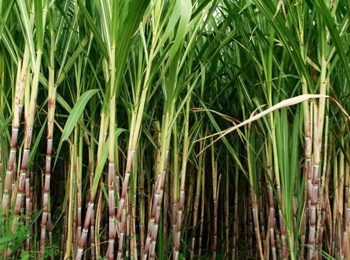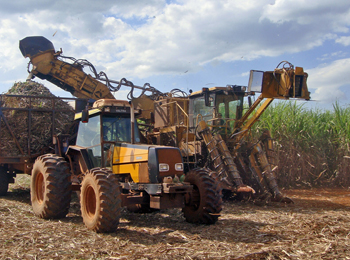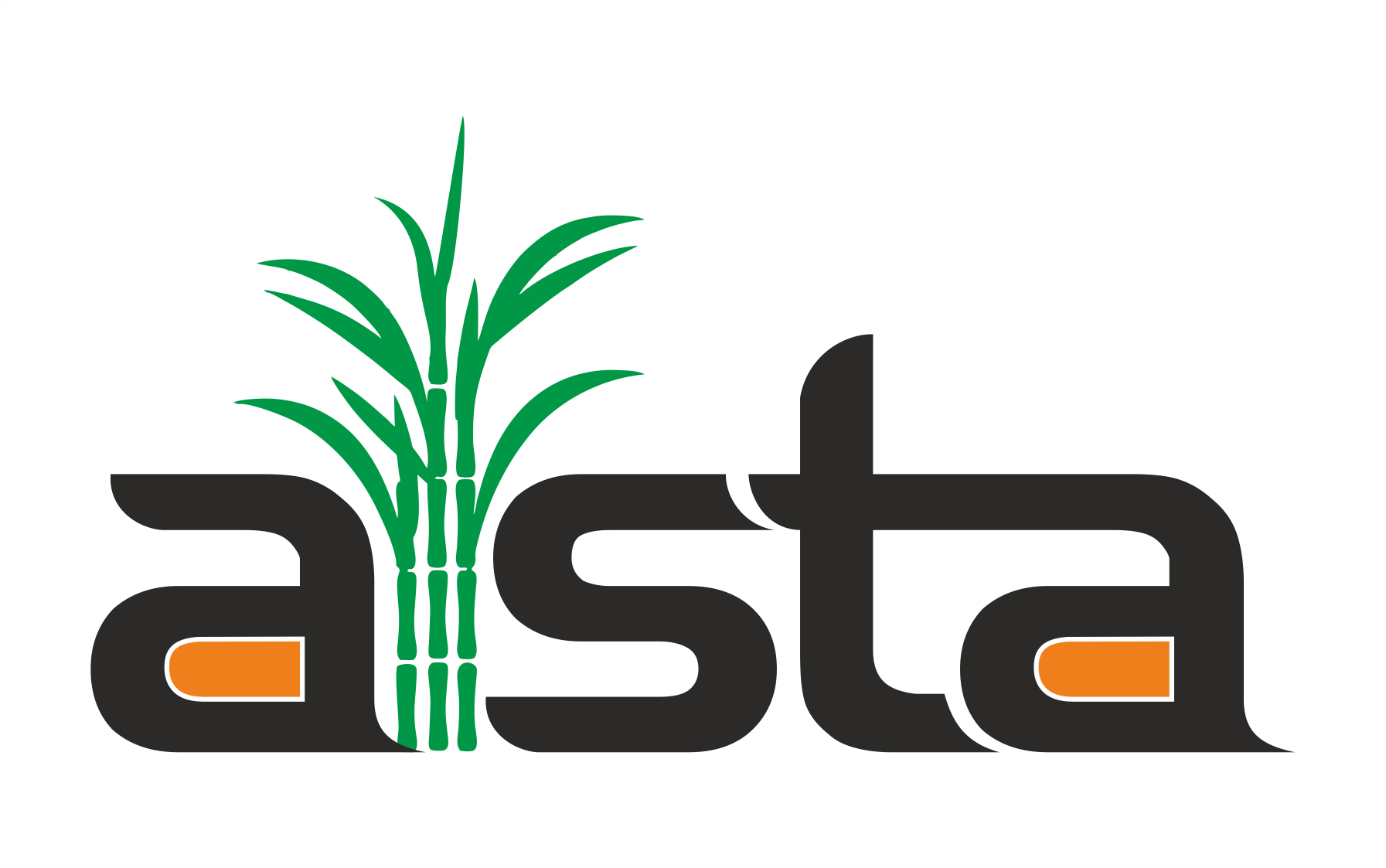
Sugarcane is one (Saccharum officinarum) of the several species of tall perennial true grasses of the genus Saccharum, tribe Andropogoneae, native to the warm temperate to tropical regions of South Asiaand Melanesia, and used for sugar production. It has stout, jointed, fibrous stalks that are rich in the sugar sucrose, which accumulates in the stalk internodes. The plant is 2 to 6 m (6 ft 7 in to 19 ft 8 in) tall. All sugar cane species interbreed and the major commercial cultivars are complex hybrids. Sugarcane belongs to the grass family Poaceae, an economically important seed plant family that includes maize, wheat, rice, and sorghum, and many forage crops.
Sucrose, extracted and purified in specialized mill factories, is used as raw material in human food industries or is fermented to produce ethanol. Ethanol is produced on a large scale by the Brazilian sugarcane industry.
Sugarcane is the world’s largest crop by production quantity.[1] In 2012, The Food and Agriculture Organization estimates it was cultivated on about 26×106 hectares (6.4×107 acres), in more than 90 countries, with a worldwide harvest of 1.83×109 tonnes (1.80×109 long tons; 2.02×109 short tons). Brazil was the largest producer of sugar cane in the world. The next five major producers, in decreasing amounts of production, were India, China, Thailand, Pakistan, and Mexico.
The world demand for sugar is the primary driver of sugarcane agriculture. Cane accounts for 80% of sugar produced; most of the rest is made from sugar beets. Sugarcane predominantly grows in the tropical and subtropical regions (sugar beets grow in colder temperate regions). Other than sugar, products derived from sugarcane include falernum, molasses, rum, cachaça (a traditional spirit from Brazil), bagasse, and ethanol. In some regions, people use sugarcane reeds to make pens, mats, screens, and thatch. The young, unexpanded inflorescence of tebu telor is eaten raw, steamed, or toasted, and prepared in various ways in certain island communities of Indonesia.[2]
The Persians, followed by the Greeks, discovered the famous “reeds that produce honey without bees” in India between the 6th and 4th centuries BC. They adopted and then spread sugarcane agriculture.[3] Merchants began to trade in sugar from India, which was considered a luxury and an expensive spice. In the 18th century AD, sugarcane plantations began in Caribbean, South American, Indian Ocean and Pacific island nations and the need for laborers became a major driver of large human migrations, including slave labor[4] and indentured servants.[5]
Sugarcane History
Sugarcane is indigenous to tropical South and Southeast Asia.[8] Different species likely originated in different locations, with Saccharum barberi originating in Indiaand S. edule and S. officinarum in New Guinea.[8] It is theorized that sugarcane was first domesticated as a crop in New Guinea around 6000 BC.[9] New Guinean farmers and other early cultivators of sugarcane chewed the plant for its sweet juice. Early farmers in Southeast Asia, and elsewhere, may have also boiled the cane juice down to a viscous mass to facilitate transportation, but the earliest known production of crystalline sugar began in northern India. The exact date of the first cane sugar production is unclear. The earliest evidence of sugar production comes from ancient Sanskrit and Pali texts.[10]

Around the 8th century, Arab traders introduced sugar from South Asia to the other parts of the Abbasid Caliphate in the Mediterranean, Mesopotamia
Christopher Columbus first brought sugarcane to the Caribbean during his second voyage to the Americas; initially to the island of Hispaniola (modern day Haiti and the Dominican Republic). In colonial times, sugar formed one side of the triangle trade of New World raw materials, along with European manufactured goods, and African slaves. Sugar (often in the form of molasses) was shipped from the Caribbean to Europe or New England, where it was used to make rum. The profits from the sale of sugar were then used to purchase manufactured goods, which were then shipped to West Africa, where they were bartered for slaves. The slaves were then brought back to the Caribbean to be sold to sugar planters. The profits from the sale of the slaves were then used to buy more sugar, which was shipped to Europe.
France found its sugarcane islands so valuable that it effectively traded its portion of Canada, famously dubbed “a few acres of snow”, to Britain for their return of Guadeloupe, Martinique and
Boiling houses in the 17th through 19th centuries converted sugarcane juice into raw sugar. These houses were attached to sugar plantations in the Western colonies. Slaves often ran the boiling process under very poor conditions. Rectangular boxes of brick or stone served as furnaces, with an opening at the bottom to stoke the fire and remove ashes. At the top of each furnace were up to seven copper kettles or boilers, each one smaller and hotter than the previous one. The cane juice began in the largest kettle. The juice was then heated and lime added to remove impurities. The juice was skimmed and then channeled to successively smaller kettles. The last kettle, the “teache”, was where the cane juice became syrup. The next step was a cooling trough, where the sugar crystals hardened around a sticky core of molasses. This raw sugar was then shoveled from the cooling trough into hogsheads (wooden barrels), and from there into the curing house.
A sugar plantation on the island of Réunion in the late 19th century

In the British Empire, slaves were liberated after 1833 and many would no longer work on sugarcane plantations when they had a choice. British owners of sugarcane plantations therefore needed new workers, and they found cheap labour in China, Portugal and India.[11][12] The people were subject to indenture, a long-established form of contract which bound them to forced labour for a fixed term; apart from the fixed term of servitude, this resembled slavery.[13] The first ships carrying indentured labourers from India left in 1836.[14] The migrations to serve sugarcane plantations led to a significant number of ethnic Indians, southeast Asians and Chinese settling in various parts of the world.[15] In some islands and countries, the South Asian migrants now constitute between 10 to 50 percent of the population. Sugarcane plantations and Asian ethnic groups continue to thrive in countries such as Fiji, Natal, Burma, Sri Lanka, Malaysia, British Guiana, Jamaica, Trinidad, Mar
Old-fashioned Indian Sugarcane Press, c. 1905
The then British colony of Queensland, now a state of Australia, imported between 55,000 and 62,500 (estimates vary) people from the South Pacific Islands to work on sugarcane plantations between 1863 and 1900.
Cuban sugar derived from sugarcane was exported to the USSR, where it received price supports and was ensured a guaranteed market. The 1991 dissolution of the Soviet state forced the closure of most of Cuba’s sugar industry.
Sugarcane remains an important part of the economy of Guyana, Belize, Barbados, and Haiti, along with the Dominican Republic, Guadeloupe, Jamaica, and other islands.
About 70% of the sugar produced globally comes from S. officinarum and hybrids using this species.
Sugarcane Cultivation:
Sugarcane cultivation requires a tropical or temperate climat
Sugarcane is cultivated in the tropics and subtropics in areas with a plentiful supply of water, for a continuous period of more than 6-7 months each year, either from natural rainfall or through irrigation. The crop does not tolerate severe frosts. Therefore, most of the world’s sugarcane is grown between 22°N and 22°S, and some up to 33°N and 33°S.[20] When sugarcane crop is found outside this range, such as the Natal region of South Africa, it is normally due to anomalous climatic conditions in the region, such as warm ocean currents that sweep down the coast. In terms of altitude, sugarcane crop is found up to 1,600 m close to the equator in countries such as Colombia, Ecuador, and Peru.[21]
Sugarcane can be grown on many soils ranging from highly fertile well-drained mollisols, through heavy cracking vertisols, infertile acid oxisols, peaty histosols, to rocky andisols. Both plentiful sunshine and water supplies increase cane production. This has made desert countries with good irrigation facilities such as Egypt some of the highest-yielding sugarcane-cultivating regions.
Sugarcane flower, Dominica
Although sugarcanes produce seeds, modern stem cutting has become the most common reproduction method. Each cutting must contain at least one bud, and the cuttings are sometimes hand-planted. In more technologically advanced countries like the United States and Australia, billet planting is common. Billets harvested from a mechanical harvester are planted by a machine that opens and recloses the ground. Once planted, a stand can be harvested several times; after each harvest, the cane sends up new stalks, called ratoons. Successive harvests give decreasing yields, eventually justifying replanting. Two to 10 harvests are usually made depending on the type of culture. In a country with a mechanical agriculture looking for a high production of large fields, like in North America, sugar canes are replanted after two or three harvests to avoid a lowering in yields. In countries with a more traditional type of agriculture with smaller fields and hand harvesting, like in the French island la Réunion, sugar canes are often harvested up to 10 years before replanting.

Sugar canes harvested by women, Hòa Bình Province, Vietnam
Sugarcane mechanical harvest, Jaboticabal, São Paulo, Brazil
Sugarcane is harvested by hand and mechanically. Hand harvesting accounts for more than half of production, and is dominant in the developing world. In hand harvesting, the field is first set on fire. The fire burns dry leaves, and chases away or kills any lurking venomous snakes, without harming the stalks and roots. Harvesters then cut the cane just above ground-level using cane knives or machetes. A skilled harvester can cut 500 kg (1,100 lb) of sugarcane per hour.[citation needed]
Mechanical harvesting uses a combine, or sugarcane harvester.[22] The Austoft 7000 series, the original modern harvester design, has now been copied by other companies, including Cameco / John Deere. The machine cuts the cane at the base of the stalk, strips the leaves, chops the cane into consistent lengths and deposits it into a transporter following alongside. The harvester then blows the trash back onto the field. Such machines can harvest 100 long tons (100 t) each hour; however, harvested cane must be rapidly processed. Once cut, sugarcane begins to lose its sugar content, and damage to the cane during mechanical harvesting accelerates this decline. This decline is offset because a modern chopper harvester can complete the harvest faster and more efficiently than hand cutting and loading. Austoft also developed a series of hydraulic high-lift infield transporters to work alongside their harvesters to allow even more rapid transfer of cane to, for example, the nearest railway siding. This mechanical harvesting doesn’t require the field to be set on fire; the remains left in the field by the machine consist of the top of the sugar cane and the dead leaves, which act as mulch for the next round of planting.


No Comments
Sorry, the comment form is closed at this time.